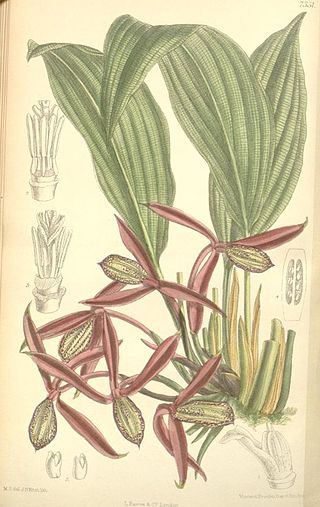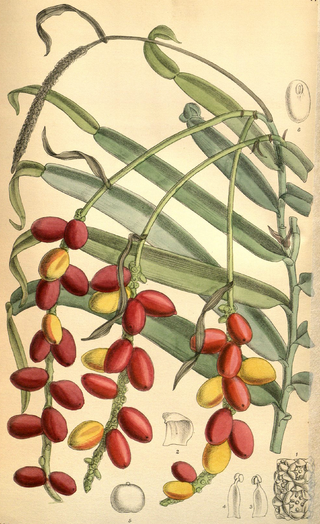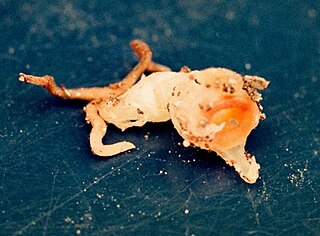| Thismia | |
|---|---|
 | |
| Thismia rodwayi | |
| Scientific classification | |
| Kingdom: | Plantae |
| Clade: | Tracheophytes |
| Clade: | Angiosperms |
| Clade: | Monocots |
| Order: | Dioscoreales |
| Family: | Burmanniaceae |
| Genus: | Thismia Griff., 1844 [1] [2] |
| Species | |
See text | |
| Synonyms [3] | |
List
| |
Thismia is a genus of myco-heterotrophic plants in family Burmanniaceae, first described as a genus in 1845. It is native to East and Southeast Asia, New Guinea, Australia, New Zealand, and the Americas. [4] [5]
- Species [3]
- Thismia abei Hatus. – Awa, Shikoku Island, Japan
- Thismia alba Holttum – S Thailand, Pahang
- † Thismia americana N.Pfeiff. – extinct, formerly Lake Calumet, Illinois, USA [6]
- Thismia angustimitra S.Chantanaorrapint [7] – Thailand
- Thismia annamensis K.Larsen & Aver. – Vietnam
- Thismia arachnites Ridl. – W Malaysia
- Thismia aseroe Becc. – Perak, Singapore
- Thismia betung-kerihunensis Tsukaya & H.Okada – Kalimantan
- Thismia bifida M.Hotta – Sarawak
- Thismia brunneomitra Hroneš, Kobrlová & Dančák [8] – Brunei
- Thismia brunonis Griff. – Myanmar
- † Thismia caudata Maas & H.Maas – extinct, formerly Brazil
- Thismia chrysops Ridl – W Malaysia
- Thismia clandestina (Blume) Miq. [7] – Java
- Thismia clavarioides K.R.Thiele [9] – New South Wales
- Thismia coronata Dančák, Hroneš and Sochor [10] – Sarawak
- Thismia crocea (Becc.) J.J.Sm. [7] – W New Guinea
- Thismia episcopalis (Becc.) J.J.Sm. [7] – Borneo
- Thismia espirito-santensis Brade – Espírito Santo, Brazil
- Thismia filiformis Chantanaorr. – Thailand
- Thismia fumida Ridl – Selangor, Singapore
- † Thismia fungiformis (Taub. ex Warm.) Maas & H.Maas – extinct, formerly Brazil
- Thismia gardneriana Hook.f. ex Thwaites – Sri Lanka
- Thismia glaziovii Poulsen – Rio de Janeiro in Brazil
- Thismia goodii Kiew – Sabah
- Thismia grandiflora Ridl. – Johor in Malaysia
- Thismia hexagona Dančák, Hroneš, Kobrlová & Sochor, 2013 [11] – Brunei
- Thismia hongkongensis S.S.Mar & R.M.K.Saunders [12] – Hong Kong
- Thismia huangii P.Y.Jiang & T.H.Hsieh – Taiwan
- Thismia hyalina (Miers) Benth. & Hook.f. ex F.Muell. – Peru, Brazil
- Thismia iguassuensis (Miers) Warm. – Rio de Janeiro in Brazil
- Thismia inconspicua Sochor & Dančák, [13] – Brunei
- Thismia janeirensis Warm – Rio de Janeiro and Minas Gerais, Brazil
- Thismia javanica J.J. Sm. – Thailand, Vietnam, Java, Sumatra
- Thismia jianfenglingensis – Hainan Island, China [14]
- Thismia kobensis – Japan (never seen alive until 2021; holotype and only specimen found in 1992 and declared extinct in 2010 but not described until 2018, It was rediscovered in 2021, 20 specimens were found in a conifer plantation [15] ) - Japan
- Thismia labiata J.J.Sm. – Sumatra
- Thismia lauriana Jarvie – Kalimantan
- Thismia luetzelburgii Goebel & Suess. – Costa Rica, Panama, Espirito Santo
- Thismia macahensis (Miers) F.Muell. – Rio de Janeiro, Brazil
- Thismia megalongensis C.Hunt, G.Steenbeeke & V.Merckx [16] – New South Wales, Australia
- Thismia melanomitra & H.Maas – Ecuador
- Thismia mirabilis K. Larsen – Thailand
- Thismia mullerensis Tsukaya & H.Okada [17] – Kalimantan
- Thismia neptunis Becc. – Sarawak
- Thismia nigricoronata Kumar & S.W.Gale [18] – Laos
- Thismia ophiuris Becc. – Borneo
- Thismia ornata Dančák, Hroneš and Sochor [10] – Sarawak
- Thismia panamensis (Standl.) Jonker – from Costa Rica to Bolivia
- Thismia racemosa Ridl. – Pahang, Malaysia
- Thismia rodwayi F.Muell. – Fairy Lanterns [9] – New South Wales, Tasmania, Victoria, New Zealand North Island
- Thismia saulensis [19] – French Guiana
- Thismia singeri (de la Sota) Maas & H.Maas – Beni, Bolivia
- Thismia sitimeriamiae Siti-Munirah, Dome & Thorogood, sp. nov. – Malaysia [20]
- Thismia taiwanensis [21] – Kaohsiung, Taiwan
- Thismia tentaculata K.Larsen & Aver. – Hong Kong, Vietnam
- Thismia thaithongiana Chantanaorr. & Suddee, 2018 – Thailand [22]
- Thismia tuberculata Hatus. – Kyushu, Japan
- Thismia yorkensis Cribb [9] – N Queensland


















